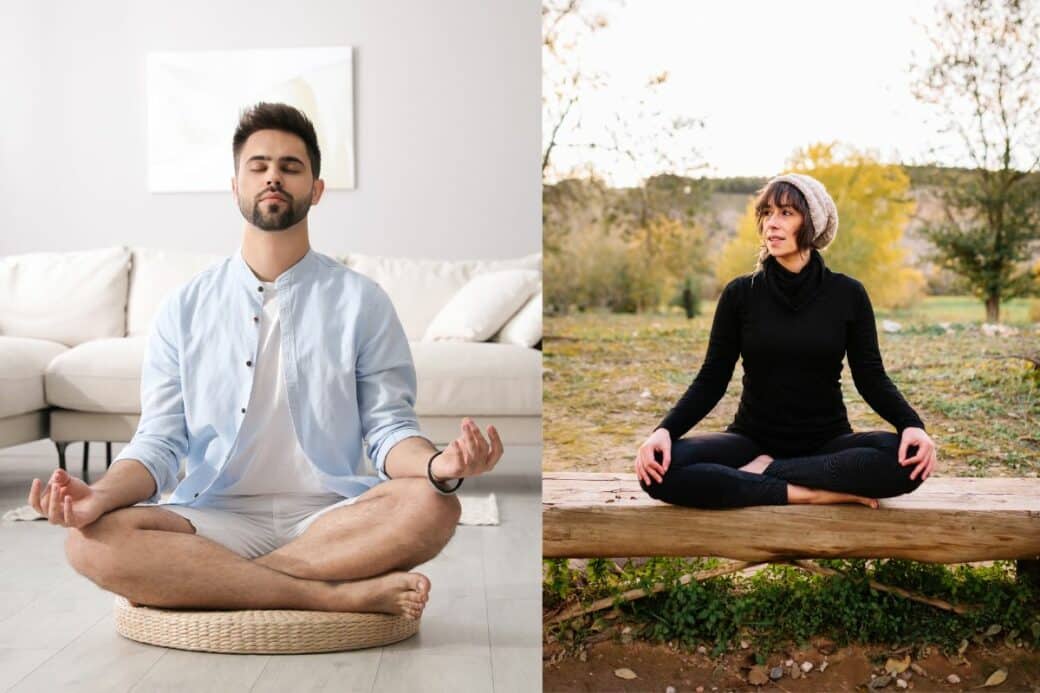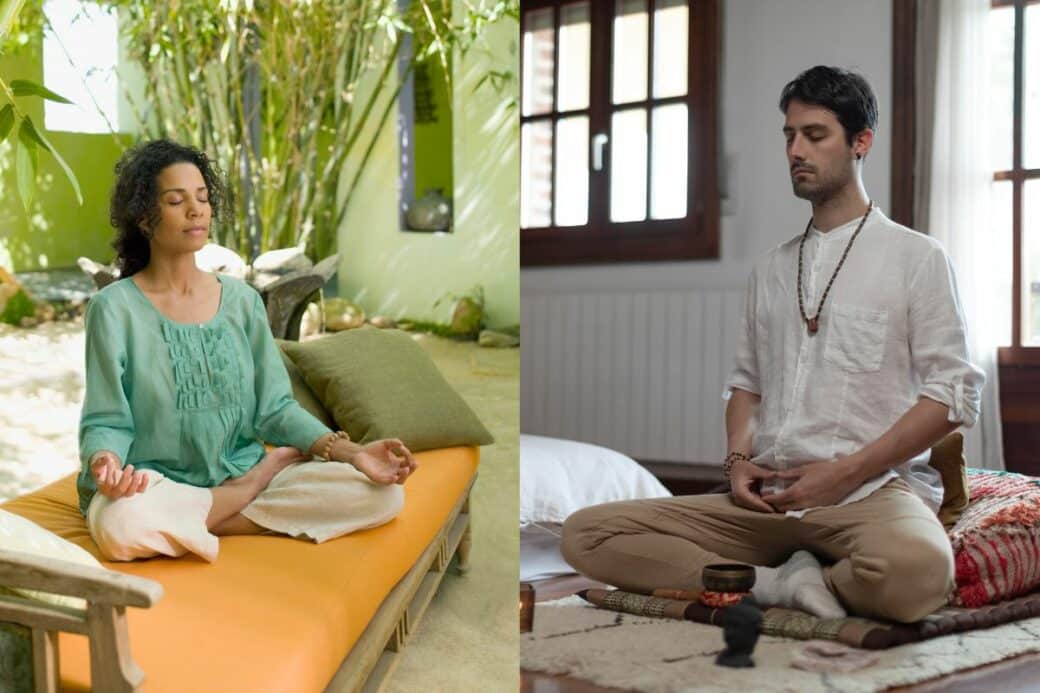Are you ready to elevate your meditation practice but unsure which meditation accessory to choose? Look no further! In this article, we will explore the pros and cons of two popular options: the meditation bench and the zafu. Whether you’re a seasoned meditator or just starting out, understanding the benefits and differences between these two seating arrangements will help you find the perfect fit for your mindfulness journey. Get ready to discover the ideal companion for your peaceful moments of serenity.

What is a Meditation Bench
Meditation Bench Vs Zafu: Definition
A meditation bench, also known as a meditation stool or seiza bench, is a piece of furniture that provides a comfortable and supportive platform for practitioners to sit on during meditation. It typically consists of a wooden or metal frame with legs that elevate the seat off the ground, allowing for a more aligned and ergonomic sitting position.
Design and Structure
Meditation benches come in various designs and structures to accommodate different body types and meditation styles. The most common design features a curved or angled seat that promotes a natural spinal alignment and reduces strain on the knees and hips. Some benches also have a cushion or padding on the seat for added comfort.
The height of the bench legs can be adjusted to suit individual preferences and sitting postures. Many benches are collapsible and lightweight, making them highly portable and convenient for travel.
Benefits of Using a Meditation Bench
Using a meditation bench offers several benefits that enhance the meditation experience and support the practitioner’s overall well-being. Here are some of the key advantages:
-
Comfort and Support: The ergonomic design of a meditation bench promotes proper posture and reduces discomfort or pain that may arise from sitting on the floor or a regular chair for extended periods. The elevated seat allows for better weight distribution and relieves pressure on the knees, ankles, and back.
-
Spinal Alignment: Sitting on a meditation bench encourages a straight and aligned spine, which facilitates deep breathing and enhances focus and relaxation. It helps prevent slouching or hunching over, which can lead to tension and fatigue during meditation.
-
Ease of Use: Meditation benches are user-friendly and require minimal setup. They provide a stable and secure seating option, allowing practitioners to focus on their meditation practice without the distractions of discomfort or instability.
-
Portability: Many meditation benches are lightweight and foldable, making them easily transportable. Whether you’re going to a meditation retreat, a park, or your favorite meditation spot, a portable bench allows you to maintain your meditation routine wherever you go.
-
Stability: The sturdy construction of a meditation bench ensures stability and support during meditation sessions. It creates a secure foundation, preventing wobbling or shifting that may distract from the focus and tranquility of the practice.
-
Versatility: Meditation benches can accommodate various sitting positions, including kneeling, cross-legged, or a combination of both. This adaptability makes them suitable for practitioners of different meditation techniques and body flexibility levels.
-
Cost: Compared to other meditation seating options, such as meditation cushions, chairs, or mats, meditation benches are often a more affordable choice. They provide long-lasting durability and value for money.
With these benefits in mind, let’s explore how a zafu, another popular meditation accessory, compares to a meditation bench.
What is a Zafu
Definition
A zafu is a traditional meditation cushion typically used in Zen Buddhism and various other meditation practices. It consists of a round or crescent-shaped cushion filled with cotton, buckwheat hulls, or kapok. The zafu lifts the hips off the ground and allows for a stable and supported sitting position.

Design and Structure
Zafus are designed to provide a comfortable and cushioned surface for seated meditation. The round shape helps distribute body weight evenly and reduces pressure points. The cushion’s filling can be adjusted to achieve the desired firmness or softness.
Traditional zafus are made with durable fabrics, such as cotton or silk, and often feature removable covers for easy cleaning. They are available in various colors and patterns, allowing practitioners to personalize their meditation space.
Benefits of Using a Zafu
Similar to a meditation bench, a zafu offers its own set of benefits that contribute to an effective and enjoyable meditation practice. Let’s explore some of the advantages:
-
Comfort and Support: The soft and cushioned surface of a zafu provides gentle support for the hips and legs, reducing strain and discomfort during long meditation sessions. The cushioning helps alleviate pressure on the knees and ankles, making it ideal for individuals with joint sensitivity.
-
Spinal Alignment: By elevating the hips slightly higher than the knees, a zafu encourages proper spinal alignment. This alignment reduces the risk of slouching, supports deep and relaxed breathing, and enhances overall posture and body awareness.
-
Ease of Use: Zafus require minimal setup and can be easily incorporated into any meditation space or routine. They are lightweight and portable, allowing practitioners to conveniently bring their cushion wherever they go.
-
Portability: Many zafus are compact and lightweight, making them convenient for travel or outdoor meditation. They can be easily packed into a bag or carried by hand, providing a familiar and comfortable seating option in any setting.
-
Stability: Zafus offer a stable and grounded seating surface, ensuring minimal movement and wobbling during meditation. This stability allows practitioners to find a sense of balance and focus without distractions.
-
Versatility: The round shape of a zafu accommodates different sitting positions, such as cross-legged, lotus, or half-lotus. It supports practitioners with varying flexibility levels and promotes a sense of physical ease and relaxation.
-
Cost: Zafus are generally an affordable and accessible meditation accessory. They provide a durable and long-lasting investment, allowing practitioners to maintain a consistent meditation practice without breaking the bank.
Now that we’ve explored the benefits of both meditation benches and zafus, let’s delve deeper into specific aspects to consider when choosing the right option for you.
Comfort and Support
Meditation Bench
A meditation bench offers excellent comfort and support due to its ergonomic design. The curved or angled seat provides a stable base that allows for proper weight distribution and reduces strain on the knees, hips, and back. Additionally, some benches come with cushions or padding, further enhancing comfort during meditation sessions. The raised seat height also makes it easier for individuals with limited flexibility to find a comfortable position.
Zafu
A zafu, with its soft and cushioned surface, offers a different kind of comfort and support. The cushioning molds to the contours of your body, providing gentle support for the hips and legs. This helps reduce pressure on the joints and promotes a relaxed posture. The rounded shape of the zafu also supports the natural curvature of the spine, enhancing overall comfort during meditation.
Ultimately, the choice between a meditation bench and a zafu depends on individual preferences and body requirements. Some practitioners may find the firmness and stability of a bench more comfortable, while others may prefer the softness and flexibility of a zafu.
Spinal Alignment
Meditation Bench
A key advantage of using a meditation bench is its ability to promote proper spinal alignment. The elevated seat encourages an upright posture, aligning the head, neck, and spine. This alignment aids in deepening the breath, increasing alertness, and reducing the risk of discomfort or pain associated with slouching or hunching over during meditation.
Zafu
A zafu also contributes to spinal alignment, albeit in a slightly different way. By elevating the hips above the knees, the zafu helps tilt the pelvis slightly forward, naturally aligning the spine. This alignment helps maintain an upright posture and prevents the lower back from rounding or collapsing. With proper spinal alignment, practitioners can experience improved breathing, enhanced focus, and a greater sense of bodily ease.
Both the meditation bench and zafu provide support for spinal alignment; however, the slight variations in their design may affect individual preferences and specific body requirements.
Ease of Use
Meditation Bench
A meditation bench is incredibly user-friendly, requiring little to no setup. Simply place the bench on a flat surface, adjust the leg height if necessary, and you’re ready to meditate. The curved or angled seat provides a stable and secure platform, allowing practitioners to focus on their meditation practice without the distractions of discomfort or instability. The versatility of a meditation bench also enables practitioners to switch between different sitting positions easily.
Zafu
Similar to a meditation bench, a zafu is also easy to use. It can be placed on a meditation mat, cushion, or directly on the floor. The lightweight and portable nature of a zafu makes it convenient for practitioners who move between different meditation spaces or locations. The cushion can be easily adjusted to achieve the desired height and firmness, accommodating individual preferences and body comfort.
Both the meditation bench and zafu offer ease of use, making them suitable options for practitioners of all experience levels.
Portability
Meditation Bench
Many meditation benches are designed with portability in mind. They are often made from lightweight materials and feature foldable or collapsible legs, making them easy to pack and carry. Whether you’re heading to a meditation retreat, a park, or your favorite meditation spot, a portable bench allows you to maintain your meditation routine wherever you go. The compact size of a folded bench also saves space when storing or traveling.
Zafu
Zafus are known for their portability and convenience. They can be easily carried by hand or placed in a bag or backpack. The compact size of a zafu makes it ideal for individuals who frequently travel or engage in outdoor meditation. Wherever you find yourself, having a zafu on hand ensures you always have a familiar and comfortable seating option for your practice.
Both the meditation bench and zafu excel in terms of portability, with each option offering its unique advantages for practitioners on the move.
Stability
Meditation Bench
Stability is a crucial factor in maintaining focus and tranquility during meditation. A meditation bench provides a stable and secure seating option, thanks to its sturdy construction and supportive design. With the legs firmly planted on the ground and the curved or angled seat providing a stable base, practitioners can remain grounded and undisturbed throughout their meditation practice. The stability of a bench is particularly beneficial for individuals who experience discomfort or knee pain when sitting on the floor.
Zafu
While a zafu may not offer the same level of stability as a meditation bench, it still provides a reliable surface for seated meditation. The cushion’s round shape helps distribute body weight evenly, preventing excessive shifting or movement during prolonged meditation sessions. The non-slip properties of some zafus also contribute to stability, ensuring that the cushion remains in place throughout your practice.
Both the meditation bench and zafu offer stability, and the choice may depend on personal preference and the practitioner’s need for additional support.
Versatility
Meditation Bench
Meditation benches are highly versatile and can accommodate various sitting positions. Whether you prefer kneeling, cross-legged, or a combination of both, a bench can be adjusted to suit your desired posture. The ergonomically designed seat and adjustable leg height make it possible to find a comfortable meditation position regardless of your body flexibility. This versatility allows practitioners to explore different techniques and experiment with their meditation practice.
Zafu
Zafus are also versatile in terms of sitting positions. Their rounded shape supports sitting styles such as cross-legged, lotus, or half-lotus. The cushion’s softness and flexibility enable practitioners to find a position that suits their body comfort and flexibility levels. This versatility makes zafus suitable for practitioners of various meditation styles, including Zen, Vipassana, and mindfulness.
Both the meditation bench and zafu offer versatility, ensuring that practitioners can find a seating option that aligns with their meditation practice and individual preferences.
Cost
Meditation Bench
In terms of cost, meditation benches are generally a more affordable option compared to other meditation accessories like chairs or mats. While prices may vary depending on the material, design, and brand, benches offer long-lasting durability and value for money. Investing in a quality meditation bench allows practitioners to establish a comfortable and supportive meditation routine without significant financial burden.
Zafu
Zafus also provide a cost-effective solution for a meditation seating option. With various price points available, zafus cater to different budget ranges. While higher-quality zafus may come with a slightly higher price tag, they often offer improved durability and comfort. The long-lasting nature of zafus ensures that you won’t need to frequently replace or upgrade your cushion.
Both meditation benches and zafus offer reasonable price options, allowing practitioners to prioritize comfort and support without breaking the bank.
Choosing the Right Option
Individual Preference
When choosing between a meditation bench and a zafu, individual preference plays a significant role. Some practitioners may find the firmness and stability of a bench more suitable, while others may prefer the cushioning and flexibility of a zafu. It is important to consider your own comfort, body requirements, and meditation style when making a decision.
Purpose of Meditation
The purpose of your meditation practice also influences the choice between a bench and a zafu. If you prioritize stability and an upright posture for deep focus and concentration, a bench may be the better option. On the other hand, if you value comfort and relaxation for a more introspective or mindfulness-based practice, a zafu may be more suitable. Understanding your meditation goals can guide you towards the option that aligns with your intentions.
Body Comfort and Flexibility Levels
Consider your body’s comfort and flexibility levels when deciding between a bench and a zafu. If you experience knee or hip discomfort, or if you have limited flexibility, a meditation bench may provide better support and alleviate strain. Alternatively, if you prefer a cushioned surface and require additional height to achieve proper alignment, a zafu may be the more beneficial choice. Taking your body’s needs into account ensures a comfortable and sustainable meditation practice.
In conclusion, both meditation benches and zafus offer distinct advantages and considerations. The choice ultimately depends on personal preference, the intended purpose of meditation, and your body’s comfort and flexibility levels. Whether you opt for a meditation bench or a zafu, prioritizing comfort, support, and alignment will enhance your meditation experience and nurture your overall well-being.




